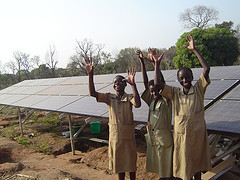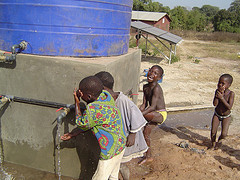DATABASE
Solar market gardens
ongoing
Country
Benin
Budget
500.000 - 3M $
Year
2007
Issue
Solutions
Link
www.self.org
Abstract
The project improves water access in two villages in Kelelè District, Benin. Solar water pumps provide fresh water for low-cost drip irrigation systems to supply vegetable orchards during the dry season. The project improves the local diet, increases and stabilizes family income and has a positive impact in terms of time saved by women.
Project Description
The project targets the Kelelè community in Benin, some 100,000 people relying on subsistence farming as their primary means of leaving. This is a semi-arid area characterized by a 6 months dry season when agricultural activity without irrigation is not possible. The area has permanent water availability but lacks technology inputs to make it possible to irrigate agricultural productive activities. The project started in 2007 with 3 pilot sites of 0,5 hectare each. Each site is divided into 40 plots. Each plot is cultivated by a woman of the local community, yet 20% of all the area is set aside to be farmed collectively. Solar water pumps take the water from a nearby river. The irrigation network consists of drip-irrigation systems in order to reduce water consumption and soil salinization. The pilot sites have shown positive impacts improving the beneficiaries’ diet, increasing their annual income and reducing the time spent by women to fetch water. In 2012-13 eight new solar market gardens have been inaugurated in the near-by villages; photovoltaic systems in secondary schools and health centres have been installed and 17 solar street lights and 6 market lights have been placed in two villages to help support nighttime vegetable sales. Finally three solar-powered community water wells have been constructed to improve access to safe water. The project has a strong local component. Local stakeholders are asked to identify their own development priorities and to decide which solar services the community needs.
BENEFICIARIES
Some 60 families directly benefiting from increased vegetable production and some 10,000 people from improved access to water. The project intends to scale up the solar and water services to the whole Kelelè population.
Results
11 solar market gardens have been realized with solar-pump and drip-irrigation systems. This has increased fresh vegetable production throughout the year and improved beneficiary diet, reducing community malnutrition. The drip-irrigation systems make it possible to cultivate vegetables during the six-months dry season and double vegetable annual yields. Beneficiaries eat 20% of the harvest within their family and sell the remaining product in the local market. This offers an income generating opportunity and the families involved in the project have doubled their income. Women in the community report they spend 50% less time fetching water than before. Two local schools and health centres benefit from access to modern energy thanks to the photovoltaic systems. Three community water wells supply the community with fresh, safe water, reducing waterborne diseases. Street lights have been installed in 2 villages, to increase security. Local markets are provided with nightlight to extend selling time.
Business Model
Local stakeholders identify the community needs in term of access to modern energy. Irrigation has been selected as the priority service. A solar garden consists of a 0,5 hectare plot divided into 40 orchards of 120 square meters each. Each is assigned to a woman and 20% of the land is farmed collectively to finance the expenses of the group. Each orchard supplies on average 20% of the family demand for vegetables, the remaining production is sold in the market. The increased production allows an extra family income of some 7,5 $ per week.
Lessons Learnt
Both solar pumps and drip irrigation are well known technologies. The solar market garden has combined the two technologies in order to provide modern energy services to the production of food at the scale of a family. A drip irrigation system matches solar energy water pumping well. It needs low pressure water and this considerably reduces capital investment in the design of the pumping system as it reduces the capacity of the solar system needed. The PV plant does not need batteries to activate the DC pump. This is an additional advantage in terms of cost and long-term reliability of the system. Finally, during the rain season the solar pumps may be used to supply fresh and safe water to the local communities.
Key Feature
The project is based on a preliminary identification of the access to modern energy that the community needs. It is designed to extend over time the dissemination of solar garden markets in the Kelelè community and to diversify the access to solar technology in order to provide other community services (schools, health centres, boreholes, street light). The matching of solar pump technology with drip irrigation systems has proved to be successful. The project has produced well-documented technical and economic reports to facilitate the replication of the experiences in other contexts. It has a strong ownership component as all infrastructures have been handed over to the community. Local partners have been involved in the project strategic choices, they implement the project locally and decide new developments. Women groups are part of project management. The pilot phase has been monitored by the University of Stanford, the impact has been assessed and project results quantified.
Other significant information
Promotion of small holder irrigation is frequently cited as a strategy for poverty reduction, climate adaptation, and promotion of food security. The drip irrigation system is an energy efficient means to deliver water and fertilizer directly to the roots of plants, reducing water losses, soil salinization and improving soil moisture conditions. It delivers yield gains of up to 100%, savings of water, fertilizer, pesticide, and labor of up to 40–80% over conventional irrigation systems. According to the project monitoring report a drip irrigation system to supply water to a 0,5 hecatare area costs approximately $18,000 corresponding to $475 per 120m2 plot. Running annual costs in terms of man-work and equipment are estimated at $5,750 for each 0,5 hectare (large plot) which corresponds to $144 per sub-plot. Annual revenues are estimated around $10,000 in the first year and $16,000 from the second year on. The estimated payback time is of approximately 2.3 years.
Implementing Actor
SELF, Solar Electric Light Fund (NGOs)


